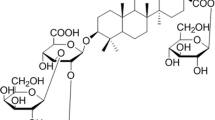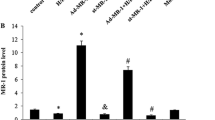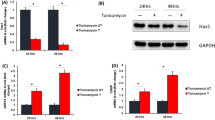Abstract
Neuregulin-1 (NRG-1) has been shown to attenuate cardiomyocyte apoptosis but the underlying signaling mechanism remains elusive. In this study, we focused on mitochondrial permeability transition pore (mPTP) opening and PI3K/Akt pathway to investigate the effects of NRG-1 on oxidative stress-induced apoptosis of cardiomyocyte. Human cardiac myocytes and neonatal rat cardiac myocytes were exposed to hydrogen peroxide with or without pre-treatment with recombinant human neuregulin-1 (rhNRG-1). Cell apoptosis and mPTP opening were assayed by flow cytometry and confocal microscopy. The activation of Akt was detected by western blot analysis. The results showed that H2O2 induced cardiomyocyte apoptosis and activated mPTP. rhNRG-1 inhibited mPTP and activated Akt in the presence of H2O2, and further protected the cells from H2O2-induced apoptosis. However, rhNRG-1 failed to inhibit mPTP opening and cell apoptosis in the presence of PI3K inhibitor LY294002. Taken together, these findings suggest that NRG-1 activates PI3K/Akt signaling and inhibits mPTP opening, and downstream apoptotic events in cardiac myocytes subjected to oxidative stress.






Similar content being viewed by others
References
Junttila TT, Sundvall M, Maatta JA, Elenius K (2000) Erbb4 and its isoforms: selective regulation of growth factor responses by naturally occurring receptor variants. Trends Cardiovasc Med 10:304–310
Hedhli N, Huang Q, Kalinowski A, Palmeri M, Hu X et al (2011) Endothelium-derived neuregulin protects the heart against ischemic injury. Circulation 123:2254–2262
Bopassa JC, Ferrera R, Gateau-Roesch O, Couture-Lepetit E, Ovize M (2006) PI 3-kinase regulates the mitochondrial transition pore in controlled reperfusion and postconditioning. Cardiovasc Res 69:178–185
Rahman S, Li J, Bopassa JC, Umar S, Iorga A et al (2011) Phosphorylation of GSK-3beta mediates intralipid-induced cardioprotection against ischemia/reperfusion injury. Anesthesiology 115:242–253
Moore XL, Tan SL, Lo CY, Fang L, Su YD et al (2007) Relaxin antagonizes hypertrophy and apoptosis in neonatal rat cardiomyocytes. Endocrinology 148:1582–1589
Predescu SA, Predescu DN, Knezevic I, Klein IK, Malik AB (2007) Intersectin-1s regulates the mitochondrial apoptotic pathway in endothelial cells. J Biol Chem 282:17166–17178
Chen Q, Chai YC, Mazumder S, Jiang C, Macklis RM et al (2003) The late increase in intracellular free radical oxygen species during apoptosis is associated with cytochrome c release, caspase activation, and mitochondrial dysfunction. Cell Death Differ 10:323–334
Remondino A, Kwon SH, Communal C, Pimentel DR, Sawyer DB et al (2003) Beta-adrenergic receptor-stimulated apoptosis in cardiac myocytes is mediated by reactive oxygen species/c-Jun NH2-terminal kinase-dependent activation of the mitochondrial pathway. Circ Res 92:136–138
Goto K, Takemura G, Maruyama R, Nakagawa M, Tsujimoto A et al (2009) Unique mode of cell death in freshly isolated adult rat ventricular cardiomyocytes exposed to hydrogen peroxide. Med Mol Morphol 42:92–101
Ky B, Kimmel SE, Safa RN, Putt ME, Sweitzer NK et al (2009) Neuregulin-1 beta is associated with disease severity and adverse outcomes in chronic heart failure. Circulation 120:310–317
Petronilli V, Miotto G, Canton M, Brini M, Colonna R et al (1999) Transient and long-lasting openings of the mitochondrial permeability transition pore can be monitored directly in intact cells by changes in mitochondrial calcein fluorescence. Biophys J 76:725–734
Baregamian N, Song J, Jeschke M, Evers B, Chung D (2006) IGF-1 protects intestinal epithelial cells from oxidative stress-induced apoptosis. J Surg Res 136:31–37
Eto K, Hommyo A, Yonemitsu R, Abe S (2010) ErbB4 signals Neuregulin1-stimulated cell proliferation and c-fos gene expression through phosphorylation of serum response factor by mitogen-activated protein kinase cascade. Mol Cell Biochem 339:119–125
Kim JS, Choi IG, Lee BC, Park JB, Kim JH et al (2012) Neuregulin induces CTGF expression in hypertrophic scarring fibroblasts. Mol Cell Biochem 365(1–2):181–189
Garratt AN (2006) “To erb-B or not to erb-B…” Neuregulin-1/ErbB signaling in heart development and function. J Mol Cell Cardiol 41:215–218
Kuramochi Y, Cote GM, Guo X, Lebrasseur NK, Cui L et al (2004) Cardiac endothelial cells regulate reactive oxygen species-induced cardiomyocyte apoptosis through neuregulin-1beta/erbB4 signaling. J Biol Chem 279:51141–51147
Horie T, Ono K, Nishi H, Nagao K, Kinoshita M et al (2010) Acute doxorubicin cardiotoxicity is associated with miR-146a-induced inhibition of the neuregulin-ErbB pathway. Cardiovasc Res 87:656–664
Zhao YY, Sawyer DR, Baliga RR, Opel DJ, Han X et al (1998) Neuregulins promote survival and growth of cardiac myocytes. Persistence of ErbB2 and ErbB4 expression in neonatal and adult ventricular myocytes. J Biol Chem 273:10261–10269
Kroemer G, Galluzzi L, Brenner C (2007) Mitochondrial membrane permeabilization in cell death. Physiol Rev 87:99–163
Vessey DA, Li L, Kelley M (2011) Ischemic preconditioning requires opening of pannexin-1/P2X(7) channels not only during preconditioning but again after index ischemia at full reperfusion. Mol Cell Biochem 351:77–84
Zhuo C, Wang Y, Wang X, Chen Y (2011) Cardioprotection by ischemic postconditioning is abolished in depressed rats: role of Akt and signal transducer and activator of transcription-3. Mol Cell Biochem 346:39–47
Yarden Y, Sliwkowski MX (2001) Untangling the ErbB signalling network. Nat Rev Mol Cell Biol 2:127–137
Jabbour A, Hayward CS, Keogh AM, Kotlyar E, McCrohon JA et al (2011) Parenteral administration of recombinant human neuregulin-1 to patients with stable chronic heart failure produces favourable acute and chronic haemodynamic responses. Eur J Heart Fail 13:83–92
Gao R, Zhang J, Cheng L, Wu X, Dong W et al (2010) A Phase II, randomized, double-blind, multicenter, based on standard therapy, placebo-controlled study of the efficacy and safety of recombinant human neuregulin-1 in patients with chronic heart failure. J Am Coll Cardiol 55:1907–1914
Hein S, Arnon E, Kostin S, Schonburg M, Elsasser A et al (2003) Progression from compensated hypertrophy to failure in the pressure-overloaded human heart: structural deterioration and compensatory mechanisms. Circulation 107:984–991
Lee Y, Gustafsson AB (2009) Role of apoptosis in cardiovascular disease. Apoptosis 14:536–548
Acknowledgments
This study was supported by Beijing Natural Science Foundation (No. 7102043). We thank Zensun Sci & Tech Ltd. (Shanghai, China) for providing neuregulin-1.
Conflict of interest
The authors declared no conflict of interest.
Author information
Authors and Affiliations
Corresponding author
Electronic supplementary material
Below is the link to the electronic supplementary material.
11010_2012_1395_MOESM1_ESM.tif
Figure S1 The effect of rhNRG-1 on mitochondrial dysfunction in HCM. Cells were treated with 200 μM H2O2 for 3 h in the presence or absence of 200 ng/mL rhNRG-1 or 50 μM LY294002 as indicated, and then incubated with calcein-AM alone and with calcein-AM in the presence of CoCl2 and analyzed by confocal microscopy. The change in calcein-AM fluorescence intensity between control cells and stimulated cells indicated the effect of rhNRG-1 on mPTP. Each experiment was repeated at least three times with similar results. Bars, 10 μm. 1 (TIFF 9671 kb)
11010_2012_1395_MOESM2_ESM.tif
Figure S2 The effect of rhNRG-1 on the activation of Bax in HCM. Cells were treated with 200 μM H2O2 for 3 h in the presence or absence of 200 ng/mL rhNRG-1 or 50 μM LY294002 as indicated. Double immunofluorescent staining of cells using anti-Bax mAb and MitoTracker Red CMXRos showed that in control cells extremely weak Bax staining was detected. At 3 h post- H2O2 treatment, Bax staining became stronger and revealed significant co-localization with the mitochondrial marker. Note also the mitochondrial fragmentation in H2O2 treatment cells compared to the controls. Each experiment was repeated at least three times with similar results. Bars, 10 μm. 2 (TIFF 10293 kb)
11010_2012_1395_MOESM3_ESM.tif
Figure S3 The effect of rhNRG-1 on the release of cytochrome c from the mitochondria in HCM. Cells were treated as indicated. Double immunofluorescent staining of cells using anti-cytochrome c mAb and MitoTracker Red CMXRos showed that in control cells extremely weak cytochrome c staining was detected. At 3 h post- H2O2 treatment, cytochrome c fluorescent staining was diffuse in H2O2 treatment cells. Note also the mitochondrial fragmentation in H2O2 treatment cells compared to the controls. Each experiment was repeated at least three times with similar results. Bars, 10 μm. (TIFF 12406 kb)
Supplementary material 4 (WMV 1661 kb)
Supplementary material 5 (WMV 1005 kb)
Rights and permissions
About this article
Cite this article
Jie, B., Zhang, X., Wu, X. et al. Neuregulin-1 suppresses cardiomyocyte apoptosis by activating PI3K/Akt and inhibiting mitochondrial permeability transition pore. Mol Cell Biochem 370, 35–43 (2012). https://doi.org/10.1007/s11010-012-1395-7
Received:
Accepted:
Published:
Issue Date:
DOI: https://doi.org/10.1007/s11010-012-1395-7




